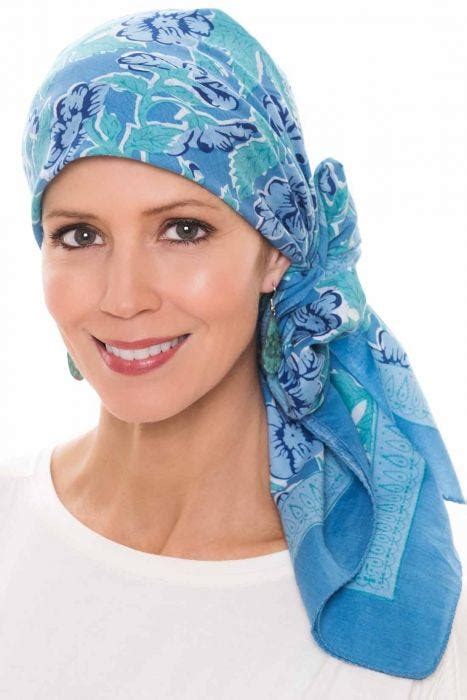Introduction
For women battling cancer, head coverings offer solace, a sense of dignity, and a means of self-expression amidst a challenging journey. Head scarves, in particular, have emerged as a symbol of resilience, adaptability, and the pursuit of normalcy during a period of significant change.

Understanding the Need for Head Scarves in Cancer Treatment
Cancer treatments, such as chemotherapy and radiation therapy, often result in hair loss, leading to physical, emotional, and psychological distress for patients. Head scarves provide a practical and stylish solution, covering the scalp comfortably while helping to maintain a sense of self.
According to the American Cancer Society, over 70% of women undergoing chemotherapy experience hair loss. Furthermore, the National Cancer Institute reports that hair loss can be a significant source of anxiety and depression, affecting patients’ self-esteem and social interactions.
Benefits of Head Scarves
Head scarves offer numerous benefits for women with cancer, including:
- Comfort: Soft and breathable fabrics provide comfort and protection for the delicate scalp, especially during and after treatment.
- Style: A wide range of designs, colors, and patterns allows women to express their individuality and create a sense of normalcy despite hair loss.
- Confidence: A well-fitting headscarf can boost confidence and empower women to feel comfortable in public, reducing feelings of self-consciousness.
- Dignity: Head coverings maintain a sense of dignity and privacy for women who may feel exposed due to hair loss.
- Protection: Scarves shield the scalp from sun exposure, cold temperatures, and other environmental factors.
Selecting the Right Head Scarf
Choosing the right headscarf involves considering factors such as:
- Material: Soft, breathable fabrics like cotton, silk, or bamboo are gentle on the scalp.
- Size: The scarf should fit snugly but comfortably around the head without causing irritation or pressure.
- Style: Select a style that complements the individual’s personality and preferences, whether it’s a classic turban, a trendy headband, or a chic infinity scarf.
- Color and pattern: Consider the skin tone, personal style, and desired level of attention. Bright colors and bold patterns can draw attention, while neutral shades may be more subtle.
Creative Applications of Head Scarves
Beyond their primary function, head scarves can be creatively used for:
- Headbands: Tie a scarf around the forehead for a comfortable and stylish way to keep hair and sweat away during exercise or daily activities.
- Choker necklaces: Wrap a narrow scarf around the neck to create a unique and eye-catching accessory.
- Face masks: Fold a scarf over the nose and mouth for protection against dust, pollen, or germs in public spaces.
- Bandanas: Knot a scarf on the head for a sporty and casual look, ideal for outdoor activities or running errands.
Customer Perspectives and Questions
Questions to Engage Customers:
- What are the most important factors you consider when choosing a head scarf?
- How do head scarves impact your confidence and self-esteem?
- What are some creative ways you have used head scarves beyond their primary function?
Customer Testimonials:
“Head scarves have given me a sense of control and normalcy during a time when I felt like everything was changing.” – Sarah, a breast cancer survivor
“I love the variety of styles available. It allows me to express my personality and feel good about my appearance despite hair loss.” – Amanda, a Hodgkin’s lymphoma survivor
Table 1: Materials for Head Scarves
| Material | Benefits |
|---|---|
| Cotton | Soft, breathable, comfortable for sensitive skin |
| Silk | Luxurious, drapes beautifully, provides protection from cold |
| Bamboo | Eco-friendly, hypoallergenic, moisture-wicking |
| Modal | Soft, silky, wrinkle-resistant |
Table 2: Types of Head Scarves
| Type | Description |
|---|---|
| Turbans | Traditional coverings that wrap around the head, providing full coverage |
| Headbands | Narrow scarves that tie around the forehead, perfect for sports or casual wear |
| Infinity Scarves | Circular scarves that can be worn in multiple ways, providing versatility |
| Bandanas | Square scarves that can be tied in various styles, adding a touch of bohemian flair |
Table 3: Pros and Cons of Different Materials
| Material | Pros | Cons |
|---|---|---|
| Cotton | Breathable, affordable | Can wrinkle easily |
| Silk | Luxurious, drapes well | Expensive, requires delicate care |
| Bamboo | Eco-friendly, hypoallergenic | Can fade over time |
| Modal | Soft, wrinkle-resistant | May be less breathable than cotton |
Table 4: Creative Applications of Head Scarves
| Application | Description |
|---|---|
| Headbands | Keep hair away during exercise or daily activities |
| Choker necklaces | Create a unique and eye-catching accessory |
| Face masks | Protect against dust, pollen, or germs |
| Bandanas | Add a sporty or casual touch to an outfit |
Conclusion
Head scarves for women with cancer are more than just coverings; they are a symbol of resilience, self-expression, and a commitment to personal well-being. By understanding the benefits, selecting the right scarf, and exploring creative applications, women can empower themselves during a challenging time and feel confident and comfortable in their own skin. As they navigate their cancer journey, head scarves provide a gentle and stylish reminder of their strength, beauty, and determination.
